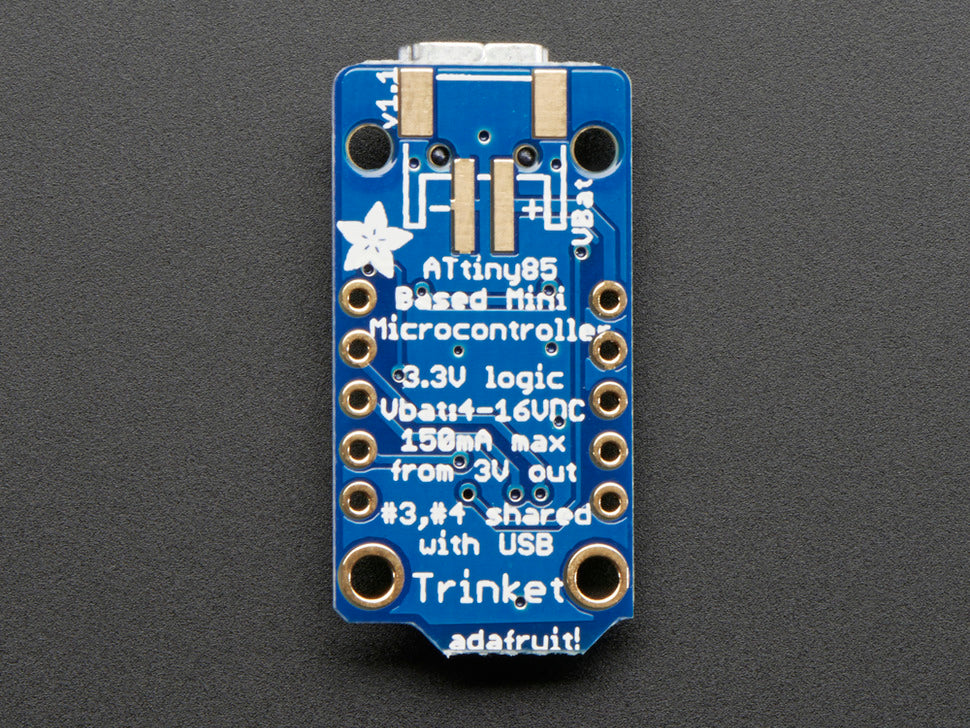

- #Adafruit trinket 3.3v how to
- #Adafruit trinket 3.3v install
- #Adafruit trinket 3.3v serial
- #Adafruit trinket 3.3v code
#Adafruit trinket 3.3v serial
These include an i2c NeoPixel driver, basic reading-writing of the EEPROM ( the Trinkets non-volatile memory ), Serial and a standard Blink.
#Adafruit trinket 3.3v code
To get you started, we’ve included some example code in the GitHub repository that should compile and upload straight onto your Trinket. Next, you can compile and upload the Blink sketch that we’ve provided in the GitHub repo: cd examples/blink To do this run: avrdude -c gpio -p attiny85Īnd you should see something like: avrdude: AVR device initialized and ready to accept instructions To test that you’ve connected the Trinket up correctly, you can ask avrdude to look for it. I suggest using the 3.3v Power and Ground pins towards the bottom of the Pi header, since these are both comfortably close to the SPI pins you’ll be using, and a safe distance from the 5v pin. These are next to each other on the top left of the Trinket ( the USB port is on the top ). If you’re following, that’s MOSI on the Pi to the second pin down on the right of the Trinket and then work your way through MISO and SCK on the Pi, and down on the Trinket- the pins are in the same order.įinally, connect the power and ground connections. When connecting the Trinket, which is our slave device, we want to connect these to SPI In, SPI Out and SPI Clock. These three pins are known as MOSI, MISO and SCK - these catchy names stand for “Master Out, Slave In”, “Master In, Slave Out” and “Clock.” Next you will need to connect up the pins that do the programming. GPIO 8 is the second to bottom most pin on the right of the Pi GPIO header. Colour Code It’s a good idea to stick with red/black wire for power/ground and pick separate colours for serial and SPI.įirst connect GPIO 8 on your Raspberry Pi to the Reset pin on the Trinket. If you’re doing this on a breadboard you’ll need 6 female-to-male jump leads power, ground, mosi, miso, clock, reset. Once you’ve got the Trinket set up on your breadboard you need to make the power and SPI connections to it from your Raspberry Pi GPIO header. Align it so that the USB port hangs over one edge, although we won’t be programming the Trinket over USB it’s a handy source of power. You should then pop the Trinket into the 170pt breadboard. This will let you push it into a breadboard and keep it securely positioned for tinkering. Connecting Them Togetherįirst, solder two 4-pin male headers to your Trinket pointing downwards.
#Adafruit trinket 3.3v install
This should install the Arduino IDE, the modified avrdude ( used for flashing programs to your Trinket ) and Arduino-Makefile which makes it easier to compile your Arduino programs from the command-line and avoid the Arduino IDE itself.Īlternatively you can manually install each component from the GitHub repo, and I'll assume you know what you're doing!. We’ve put together a simple setup script which will get you set up in a jiffy, just: git clone If you’re running Raspbian you can just grab the contents of our GitHub repository. You’ve got two choices when it comes to setting up the software. We recommend our Jumper Jerky to make all the necessary connections. If you have male to male wires and an extra breadboard handy you can use the Adafruit Pi T-Cobbler to clarify where the SPI, power and Serial pins are. A Raspberry Pi ( model A or B will do ) running Raspbian.6 female to male jump wires for power/programming.To get your Trinket and Pi connected, you’re going to need a few bits and bobs. The 3 remaining pins are reserved for power, ground and reset. Two of these can be configured as analog inputs and two as PWM outputs.
#Adafruit trinket 3.3v how to
The skills you pick up from tinkering with a Trinket and learning how to program it will also be transferable should you decide to try any Arduino products.

One that you can not only use with your Pi, but as a stand-alone controller.

The trinket is a cheap and flexible alternative to a PWM driver, or an analog to digital converter.



 0 kommentar(er)
0 kommentar(er)
